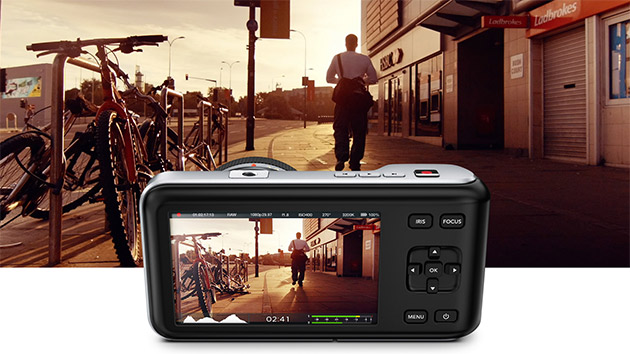Once upon a time, you bought a camera and made the most of the investment, putting up with any feature limitations until it made financial sense to invest in a more current model. But in the new camera landscape, you don't always have to buy new hardware to get new features — just download the latest firmware. (Sometimes it's even free!) Here's a look at new camera updates from Blackmagic Design, ARRI, and unofficial Canon EOS firmware provider Magic Lantern, plus a few more news briefs from the world of cinematography.

Blackmagic Firmware v1.9.3 Adds HUD to BMCC, Pocket Cinema Camera
Blackmagic brings a new histogram display, audio meters, and time-remaining indicators to the Blackmagic Cinema Camera and Pocket Cinema Camera with its latest firmware update. (The Blackmagic Production Camera 4K got the same upgrade last month.) The new display is accessed on the BMCC by swiping up from the bottom of the screen, or, if a manual lens is mounted, simply hitting the Iris button. On the Pocket Cinema Camera, the Up and Down buttons show and hide the display. Blackmagic has also added new options for white balance and shutter angle, and fixed a ProRes bug that affected in-camera playback.
ARRI Alexa Update to Support Sony SxS Pro+ Cards, Plus ProRes 4444 XQ
ARRI entered the second public beta phase with its new software update packet (SUP), v10.0. We don't recommend you go out and install beta software on your production camera, but this should mean a stable release is right around the corner. The latest feature to be added is support for Sony SxS Pro+ memory cards, which come in 64 GB and 128 GB versions. As promised, this update will support the new Apple ProRes 4444 XQ codec, but something had to go — ProRes 422 LT and ProRes 422 Proxy are being removed from all Alexa cameras, according to the official release notes [PDF]. Other added features include 180-degree image rotation for use on Steadicam as well as with ARRI's 9.5-18mm ultra-wide zoom lens, support for two independent HD-SDI outputs on a broader range of recording modes, and faster switching between regular and high-speed mode (now down to about 20 seconds).
Magic Lantern Says it Has Pushed Canon 5D Mark III to Shoot 1080p Raw at 40fps
At Planet5D, Barry Andersson noticed that Magic Lantern's custom firmware now claims to support shooting 1080p raw footage at 40fps on the Canon 5D Mark III. That's not exactly a game-changer, but it could come in handy for mild slo-mo effects — and, as Andersson notes, if you plan to fake real slow-motion in post, those extra frames will give your software a lot more information to work with. (If you haven't loaded Magic Lantern's code onto your Canon DSLR yet, be aware that it's unsupported by Canon and will void your warranty.)

Maxell Becomes Latest Maker of Camera Gear
Media storage specialist Maxell, still probably best-known for its run as a high-end audiocassette manufacturer in that formats 1980s heyday, is reinventing itself as a maker of pro camera accessories. It's debuting a line of power shoe adapters, a shoe clamp, power connectors, and a USB charge adapter that allows a smartphone or tablet to be charged using a camera battery.

Writer Jack Amiel on The Knick, the Red Dragon Camera, and Why the Eyes Have It
Director Steven Soderbergh makes his Cinemax series The Knick look unlike anything else on television, and writer Jack Amiel, one of the show's creators, thinks it has a lot to do with the Red Dragon camera's low-light capabilities, and what that means for the actors on set. From an interview with NPR:
The dim lighting was Steven Soderbergh's brilliant choice and it was real. This was not an era when you had high-wattage light bulbs and everything was lit. It was an era when this was all new and not everything was wired for electricity and we wanted the reality of the darkness and the grit and what life really was like. Technology, ironically, helped with this because Steven uses the camera called the Red Dragon and it has such an incredibly sensitive light sensor that you can be in a room where two characters are only lit by one candle in the center of the table and you can shoot that scene. It can bring more light or less light. It is extraordinary. And so Steven really took advantage of that and allowed us to see what the darkness really was back then. And I think it's wonderful. I think it's something you don't see in anything else. Steven also mentioned something that I thought was really interesting, which is that he kept trying to figure out why there was a different quality to the show than anything he'd done before. And when he was editing it he kept looking at it. And what he noticed was that the actors' eyes were different, and it was because they weren't in bright light. So instead of dialing down their pupils, they were wide open. And it had a whole different effect and a sense of openness that I don't think many other productions have ever been able to capture.
New episodes of the current 10-episode season of The Knick premiere every Friday night on Cinemax.
Topics: Blog Useful Tools Alexa ARRI blackmagic design bmcc Cameras canon 5d mark iii magic lantern maxell pocket cinema camera Red red dragon
Did you enjoy this article? Sign up to receive the StudioDaily Fix eletter containing the latest stories, including news, videos, interviews, reviews and more.

Leave a Reply